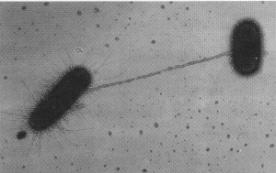 Sex
and Reproduction
Sex
and Reproduction Sex
and Reproduction
Sex
and Reproduction
If you know anything about bacteria then you probably know that they are all the same ‘sex’ and that they reproduce by growing in size and splitting into two smaller bacteria that repeat the process.
This is true as far as it goes. It is not the whole story however – bacteria do have a mechanism for passing DNA to each other in a special form called a plasmid (below).
Plasmids are circles of DNA with some special features:
· They are reproduced when the cell divides.
· Each new cell receives at least one of the plasmids.
· They often contain useful genes
The best way to illustrate this is by an example: a fictional bacteria (Alanococcus) lives in my sink – to get rid of it, I use lots of antibiotic washing up liquid. Unfortunately, by doing this, I encourage antibiotic resistant versions of Alanococcus (and anything else in my sink – this is because of Darwin's ‘survival of the fittest’). If the antibiotic resistance is due to a plasmid then this may be passed on to other bacterium – this will instantly give that new bacterium antibiotic resistance too.
This is basically how bacteria become antibiotic and how antibiotic resistance spreads so fast.
So how do the bacteria pass on plasmids?
 There
are several methods but the one I will detail uses a special bacterial organ
called a pilus – this is a long stiff tube that is put out by the bacteria.
The formation of this tube is caused by a special plasmid called the f
plasmid (‘f’ for fertility).
There
are several methods but the one I will detail uses a special bacterial organ
called a pilus – this is a long stiff tube that is put out by the bacteria.
The formation of this tube is caused by a special plasmid called the f
plasmid (‘f’ for fertility).
This tube can contact other bacteria that do not have the f plasmid and when this contact is achieved, a copy of the plasmid passes from the original bacterium to the new one – this means that the new one can make a pilus too and the process can proceed further. This process takes about two minutes.
If this plasmid (or another that may travel with it) contains a gene for antibiotic resistance then the newly ‘infected’ bacterium will quickly (within hours) become resistant. Note that antibiotic resistance genes are not always passed when plasmid transfer occurs, and that resistance to one antibiotic does not necessarily mean resistance to others.
Note the 'hairy' appearance of the f+ bacterium. This is normal.
The process described above is called ‘bacterial conjugation’. It is not the only way that bacteria may pass genes to each other.
t Back Return to Introduction Next u